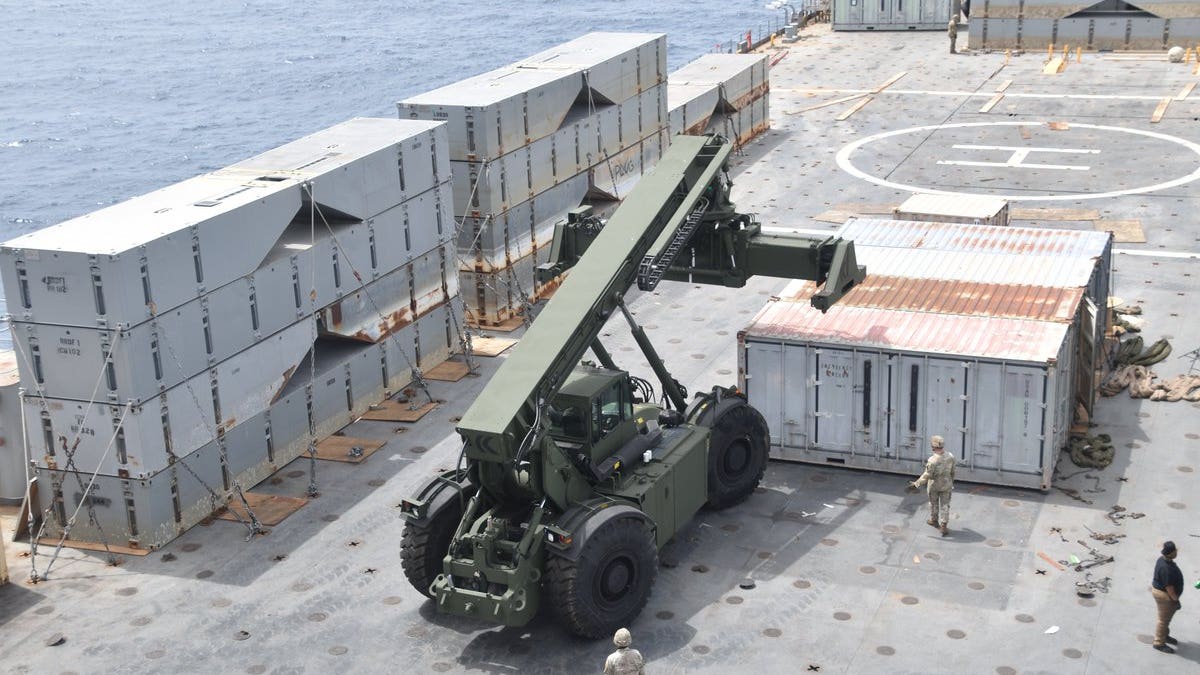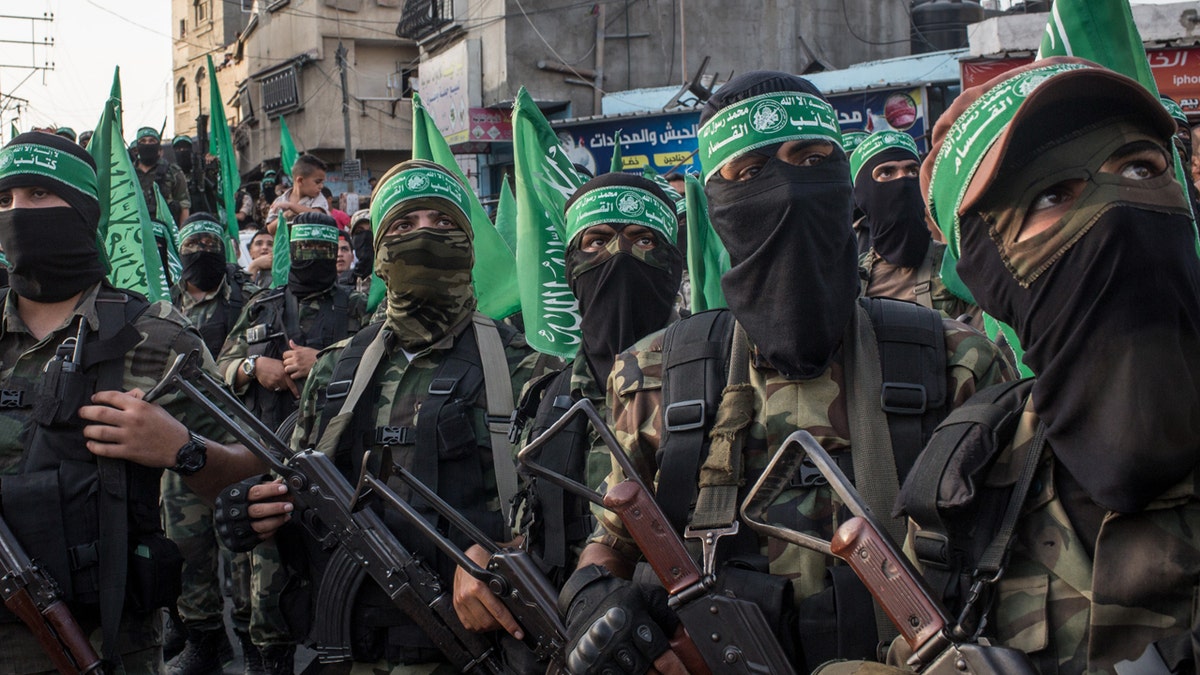Security concerns arise over pier construction in Gaza
Fox News correspondent Jeff Paul has the latest from Tel Aviv on 'Special Report.'
JERUSALEM – The rising costs of a floating pier off the coast of the embattled Gaza Strip – said to be aimed at enabling shipments of humanitarian aid to reach the civilian population trapped in the central and northern parts of the Palestinian enclave – has stoked controversy after it was revealed this week that the project will cost the U.S. upward of $320 million.
On Tuesday, the U.S. Central Command posted photographs on X of the pier under construction by U.S. soldiers in the Mediterranean Sea, saying that the hulking metal platform "will support USAID and other humanitarian partners who will receive and deliver humanitarian aid to the people of Gaza."
However, some have questioned the effectiveness of the Joint Logistics Over-the-Shore (JLOTS) pier after the Pentagon revealed on Monday that the estimated cost would nearly double the original estimate of $180 million. It also said the project will only be in use temporarily, for a period of three months.
BIDEN'S VISION FOR A PALESTINIAN STATE DOOMED, EXPERTS SAY: 'AN EXPLICIT RECOGNITION OF HAMAS'

U.S. Central Command posted that the "construction of the floating JLOTS pier in the Mediterranean is underway." (CENTCOM)
In a statement on X, Sen. Roger Wicker, R-Miss., called the project "ill-conceived," writing that "the cost has not just risen. It has exploded."
"This dangerous effort with marginal benefit will now cost American taxpayers at least $320 million to operate the pier for only 90 days," he wrote. "How much will taxpayers be on the hook once – or if – the pier is finally constructed? For every day this mission continues, the price tag goes up and so does the level of risk for the 1,000 deployed troops within range of Hamas’ rockets."
"During the State of the Union address, President Biden announced that he has directed the U.S. military to undertake an emergency mission to establish a maritime corridor and temporary pier in Gaza, working in partnership with like-minded countries and partners, to allow assistance to flow by sea directly into Gaza, as part of a sustained effort to increase U.S. aid coming into Gaza by land, air, and sea," a State Department spokesperson said in a statement to Fox News Digital.
"This temporary pier will bring much-needed assistance into Gaza, but I want to be clear: this work is in addition to our other, ongoing efforts to continue sustaining and expanding assistance going in by land," the spokesperson said.

The pier is being constructed for use to deliver aid to Gaza. The pier was first announced by President Biden during his State of the Union speech earlier this year. (CENTCOM/Getty Images)
According to a Guardian report, aid will arrive at the pier in commercial ships sailing from Cyprus. From there, pallets will be loaded on to trucks, which will then travel on smaller ships that will transport them to a floating two-lane causeway leading to the shore. The first shipment is expected to arrive next week.
WHY MIDEAST NEIGHBORS WON'T OFFER REFUGE TO PALESTINIANS STUCK IN GAZA WAR ZONE
Slated to process up to 2 million meals a day for the people in Gaza, the Pentagon said, the project has also raised concerns about security, particularly for U.S. troops who will remain off the coast aboard aircraft carriers.
Responding to a question posed by Rep. Matt Gaetz, R-Fla, during the House Armed Services FY25 budget hearing on Tuesday, regarding the possibility of threats facing the roughly 1,000 U.S. servicemen and women working to construct the pier, Defense Secretary Lloyd Austin said they would all be armed and, if attacked from Gaza, they would "have the right to return fire to protect themselves."
Kobi Michael, a senior researcher at the Institute for National Security Studies and the Misgav Institute for National Security and Zionist Strategy, told Fox News Digital that the big question was who would operate the pier once the construction process was complete.
"Once the pier is constructed, U.S. soldiers will not remain there and the pier will be operated by others," he said, adding that there was a lingering danger that Hamas, the Islamist terror group whose brutal Oct. 7 terror attack sparked a full-scale war with Israel, would try to sabotage the project if it were allowed to remain intact.

An Egyptian truck driver replaces a tarp covering humanitarian aid after being checked on its way to Gaza at the Kerem Shalom Crossing after arriving from Egypt on Dec. 22, 2023 in Kerem Shalom, Israel. (Photo by Alexi J. Rosenfeld/Getty Images)
"As long as Hamas still exists, as long as they are still in power in some parts of Gaza or able to operate militarily, they will not enable this to operate unless it is put directly under their control," Michael said. "If the Americans give the Qataris the authority to operate the pier, that means it will really be Hamas who operates the pier via a local company," he claimed.
Michael noted that the pier project directly contradicts another U.S. goal relating to the seven-month-old war in Gaza: bringing about a ceasefire between Israel and Hamas.
According to reports this week, the U.S. is hopeful Hamas, which still controls the southern tip of the Gaza Strip, will agree to the terms of a newly drafted ceasefire agreement to release some of the 133 hostages it kidnapped during its Oct. 7 attacks in exchange for Israeli troops withdrawing from all or most of the territory, as well as the release of hundreds of Palestinian terrorists being held in Israeli jails.
WORLD HEALTH ORGANIZATION SILENT OVER HAMAS’ USE OF GAZA HOSPITAL AS TERROR HQ

Six humanitarian aid trucks containing aid from the World Food Program entering the northern Gaza Strip from Israel. (IDF Spokesman's Unit)
"U.S. pressure on Israel to accept all of Hamas’ demands could mean that the IDF will not be there to secure the pier, on the other hand, the U.S. expects the IDF to secure the pier once it is ready – how will those two concepts work together?" Michael said.
"If the IDF is there to protect the pier, that means they will need to be there to secure the transfer of the humanitarian aid from the ships to the pier; then to the trucks and then to escort the trucks to distribution centers and help secure the distribution inside the Gaza Strip," he added. "Ultimately, that means having a permanent IDF presence on Gaza soil."
The Israel Defense Forces (IDF) international spokesman Lt. Col. Nadav Shoshani told the media over the weekend that the JLOTS project was extremely complicated, not only because it is located in a war zone, but also because of the amounts of aid that would be entering Gaza.

Hamas terrorists are seen during a military show in the Bani Suheila district on July 20, 2017 in Gaza City, Gaza. (Chris McGrath/Getty Images)
"This is not a simple operation, and the IDF is involved in many parts of it," he said, adding that Israel was "very committed" to the effort and that it would come as an addition to the sharp increase in aid that has been entering Gaza via the land and the air over the past few weeks.
"The aid will be checked in Cyprus, same as they have been checked everywhere," said Shoshani, referring to Israel’s security operations at crossings from Egypt into Gaza and also from Jordan into the West Bank and then to Gaza.
CLICK HERE TO GET THE FOX NEWS APP

Trucks with humanitarian aid for the Gaza Strip enter from Egypt on Saturday, Oct. 21. (AP/Fatima Shbair)
"I don’t know how they plan to convert this in the long term, but the provision of approved and screened aide by an allied European country is a major step up from relying on Egypt to handle this task," Jonathan Schanzer, the senior vice president for research at the Foundation for Defense of Democracies in Washington, told Fox News Digital.
"If the Cypriot channel can be institutionalized, and the Egyptian border can be secured both above and below ground, this could prevent the re-arming of Hamas for years to come," he said, adding, "If this can be solidified and made permanent, it would be a net benefit for the entire region."





















